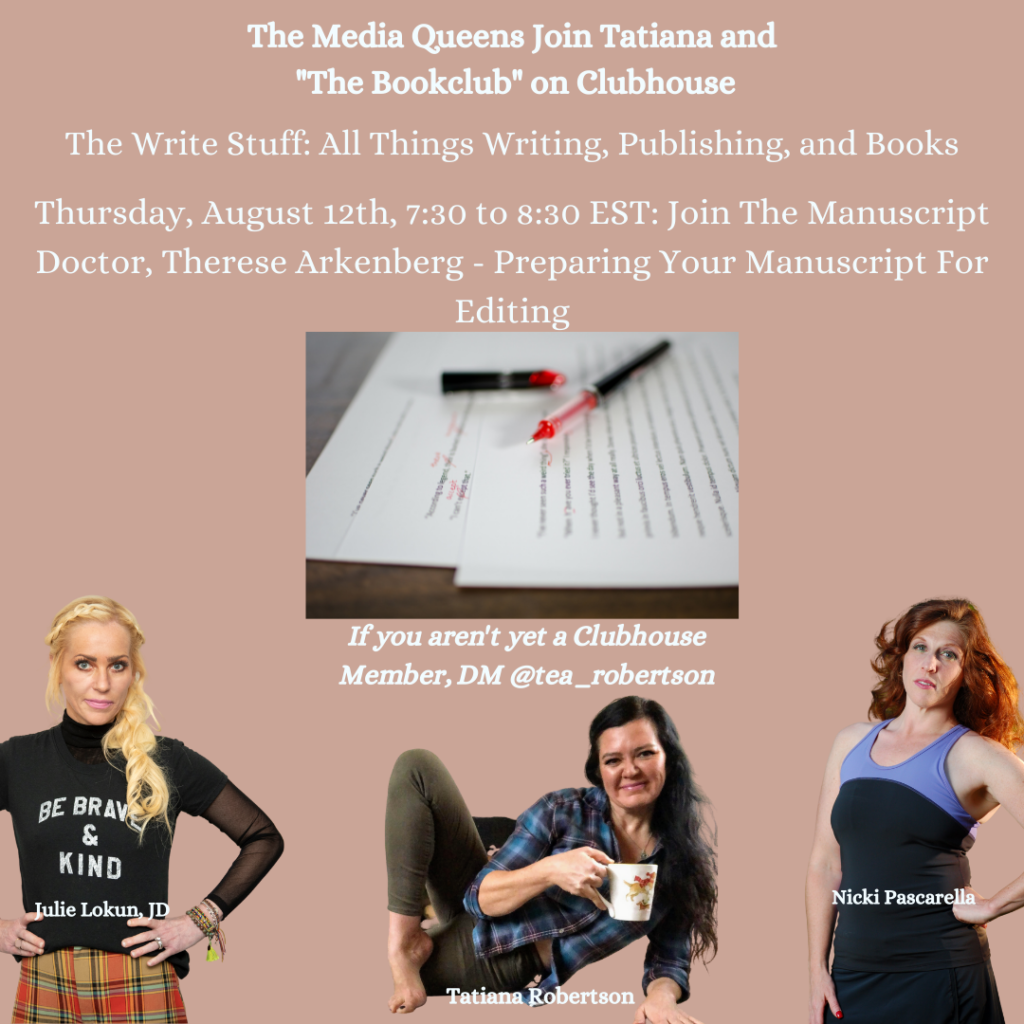
I hope many of you will be able to join me!
As I prepare for my live chat with Nicki tomorrow, I have some notes that I’d like to share here on my website, both for listeners to follow along with, and for those who aren’t able to make it to benefit from:
A. Copyediting, proofreading, line-by-line — what do all these terms mean?
Developmental/structural/content edit – literally developing the ideas in the book. What to include and in what order? Add, reorganize, remove? Often done through letters and memos rather than margin notes like other editing. Sometimes discussed in phone calls or face-to-face, especially at bigger publishers or with commissioning editors (who may be the ones to come up with a book idea, then hire an author to write it). Also helps to complete first draft of a book – spot plot holes, opportunities to expand, unnecessary subplots, inconsistencies, etc.
Proofreading – Is this misspelled? Did you forget that comma? Many consider this the “bare minimum” but I’ve found that hiring someone just to proofread a manuscript that has big issues on larger levels (unclear POV, plot holes, very repetitive) is worse than useless. Proofread after other editing has been done, not as the only edit. But do proofread. Better yet, get fresh eyes to proofread.
Copyediting – Generally in the publishing workflow this is the penultimate step before proofreading. Involves checking for grammatical correctness, stylistic consistency, and precision and clarity in phrasing. More detailed than proofreading, but more limited than line editing.
Line editing – My main service, my favorite <3. Clarity, consistency, and grammatical correctness, of course, but also opportunities to deepen POV, find stronger word choice, adjust pacing. Make your words work for you, make them sing and play for the reader. (Doesn’t mean they’ll come out all fancy and lyrical. Hemingway did a lot of line editing to create his powerfully direct, sparse prose. It’s more a matter of making sure whatever style you’re developing is fully developed.)
Rewriting & Ghostwriting – Not a service I offer, but can be helpful for those who have a story to tell but aren’t writers (especially for nonfiction). Two extreme classes of clients: those who don’t want a word of their work changed, and those who would rather not do the work of changing anything but are fine with someone else doing so. Best to find a happy medium between the two. I never rewrite text except as an example of a clearer/less ambiguous way to say something. (However, if I recommend changing something, often it does need to be changed—the original was confusing or distracting—just not necessarily in the exact way I offer as an example.)
B. Tips to prepare for a manuscript edit
Whether developmental or line-by-line, there are some things you can do before I receive your manuscript to make my suggestions the most helpful to you:
1. Read through the manuscript at least once on your own to catch inconsistencies, things you want to change, and typos. You don’t want to pay me to change “teh” to “the” when you know to do that already.
2. TENSE: Accidental changes in tense happen. I often find myself beginning a story in past tense then slipping into present. Even proofreading can’t always catch it—but you can try, and what you CAN do is let your editor know what tense you want the story to be in upfront. Otherwise I might have a manuscript that’s 50% past tense, 50% present, and have to make a guess or wait for the author to respond to my question before I can start editing. (If you are deliberately using multiple tenses, such as with flashbacks, just share a quick note explaining when you change tense and why.)
3. POV: You should have a point of view. Ideally it’s one of the characters, and only one character per scene (this has become the common preference of most modern readers). “Omniscient narrators” are best when they have their own opinions and personality – think God narrating Good Omens – and even then it’s a tradeoff, sometimes a gamble. No matter what, know what POV you’ve chosen and why. Word choice should reflect the POV. “Filter words” are often unnecessary. I encourage many authors to get more intimate with their characters so readers can be close to them, too.
4. DIALOGUE: “she said” or “he asked” is usually enough; you don’t need characters to “utter” or “ejaculate”. Explanations of how to punctuate dialogue are common (here’s an excellent, thorough post: http://theeditorsblog.net/2010/12/08/punctuation-in-dialogue/) and you’ll get the hang of it through practice. Just remember “she said” is part of the same sentence as what she said, so “she” shouldn’t be capitalized if it follows the dialogue, she said. Getting the punctuation correct saves time, and also reduces my chances of developing carpal tunnel, so thank you! she said.
5. CLARITY: I can’t help you say it best if I’m not sure what you want to say. Thanks to the “curse of knowledge” it’s normal to write things that are clear to you but not to the reader; it’s one big reason why we edit. But if you have to choose between elegant phrasing and clarity on an early draft, chose clarity. I can help you think of elegant phrasing once I know what the idea is we’re trying to communicate elegantly.
6. FORMATTING: I can adjust the manuscript format on my own, so don’t sweat over it, but it’s very helpful if authors do not use tabs or add extra spaces or blank lines (I or your formatter will have to remove all of these). For pieces to be submitted to agents or publishers, William Shunn’s Standard Manuscript Format webpages are classic guides for short fiction and for book-length work: https://www.shunn.net/format/story/
Lastly, my new GUIDED PRE-EDIT service helps target words that often signal issues with POV, repetition, even tense (since they include a few key verbs). I encourage all authors to pre-edit and some guidance from me can make it even more helpful.

 Therese Arkenberg's first short story was accepted for publication on January 2, 2008, and her second acceptance came a few hours later. Since then they haven't always been in such a rush, yet her work appears in places like Beneath Ceaseless Skies, Analog, Daily Science Fiction, and the anthology Sword & Sorceress XXIV. Aqua Vitae, her science fiction novella, was released by WolfSinger Publications in December 2011.
She works as a freelance editor and writer in Wisconsin, where she returned after a brief but unforgettable time in Washington, D.C. When she isn't reading, writing, or editing (it's true!) she serves on the board of the Plowshare Center of Waukesha, which works for social, economic, and environmental justice.
Therese Arkenberg's first short story was accepted for publication on January 2, 2008, and her second acceptance came a few hours later. Since then they haven't always been in such a rush, yet her work appears in places like Beneath Ceaseless Skies, Analog, Daily Science Fiction, and the anthology Sword & Sorceress XXIV. Aqua Vitae, her science fiction novella, was released by WolfSinger Publications in December 2011.
She works as a freelance editor and writer in Wisconsin, where she returned after a brief but unforgettable time in Washington, D.C. When she isn't reading, writing, or editing (it's true!) she serves on the board of the Plowshare Center of Waukesha, which works for social, economic, and environmental justice.